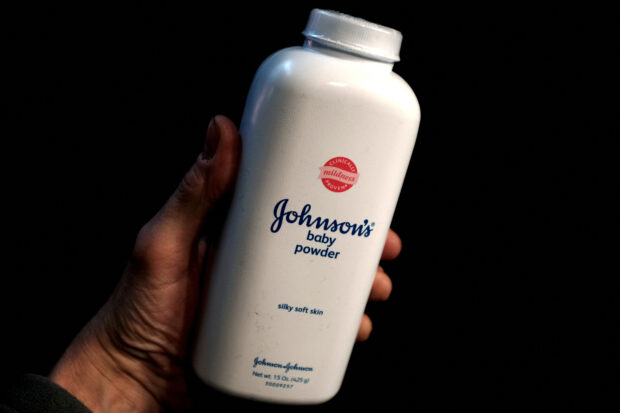
A bottle of Johnson and Johnson Baby Powder is seen in a photo illustration taken in New York, February 24, 2016. REUTERS/Mike Segar/Illustration/File Photo
Johnson & Johnson’s must pay $18.8 million to a California man who said he developed cancer from exposure to its baby powder, a jury decided on Tuesday, a setback for the company as it seeks to settle thousands of similar cases over its talc-based products in U.S. bankruptcy court.
The jury ruled in favor of Emory Hernandez Valadez, who filed suit last year in California state court in Oakland against J&J, seeking monetary damages. Hernandez, 24, has said he developed mesothelioma, a deadly cancer, in the tissue around his heart as a result of heavy exposure to the company’s talc since childhood. The six-week trial was the first over talc that New Brunswick, New Jersey-based J&J has faced in almost two years.
The jury found that Hernandez was entitled to damages to compensate him for his medical bills and pain and suffering, but declined to award punitive damages against the company. Hernandez will not be able to collect the judgment in the foreseeable future, thanks to a bankruptcy court order freezing most litigation over J&J’s talc.
J&J vice president of litigation Erik Haas said in a statement that the company would appeal the verdict, calling it “irreconcilable with the decades of independent scientific evaluations confirming Johnson’s Baby Powder is safe, does not contain asbestos and does not cause cancer.”
A lawyer for Hernandez could not immediately be reached for comment.
Reuters watched the trial through Courtroom View Network.
In closing arguments to the jury on July 10, J&J’s lawyers said there was no evidence either linking Hernandez’s kind of mesolthelioma to asbestos or proving that Hernandez was ever exposed to tainted talc. Hernandez’s lawyers during closing arguments accused J&J of a “despicable” decades-long coverup of asbestos contamination.
Hernandez testified in June, telling jurors that he would have avoided J&J’s talc if he had been warned that it contained asbestos, as his lawsuit alleges. Jurors heard from Hernandez’s mother, Anna Camacho, who said she used large amounts of J&J’s baby powder on her son when he was a baby and through childhood. She cried as she described Hernandez’s illness.
Tens of thousands of plaintiffs have sued, alleging that J&J’s baby powder and other talc products sometimes contained asbestos and caused ovarian cancer and mesothelioma. J&J has said its talc products are safe and do not contain asbestos, which has been linked to mesothelioma.
J&J subsidiary LTL Management in April filed for bankruptcy in Trenton, New Jersey, proposing to pay $8.9 billion to settle more than 38,000 lawsuits and prevent new cases from coming forward. It was the company’s second attempt to resolve talc claims in bankruptcy, after a federal appeals court rejected an earlier bid.
Most litigation has been halted during bankruptcy proceedings, but U.S. Chief Bankruptcy Judge Michael Kaplan, who is overseeing LTL’s Chapter 11, let Hernandez’s trial proceed because he is expected to live only a short time.
Hernandez’s form of mesothelioma is extremely rare, making his case different from the vast majority pending against J&J.
Asbestos plaintiffs are seeking to have LTL’s latest bankruptcy filing dismissed. They have argued the filing was brought in bad faith to insulate the company from litigation.
J&J and LTL have argued that bankruptcy delivers settlement payouts to plaintiffs more fairly, efficiently and equitably than trial courts, which they have likened to a “lottery” in which some litigants get large awards and others nothing.
J&J said in bankruptcy court filings that the costs of its talc-related verdicts, settlements and legal fees have reached about $4.5 billion.